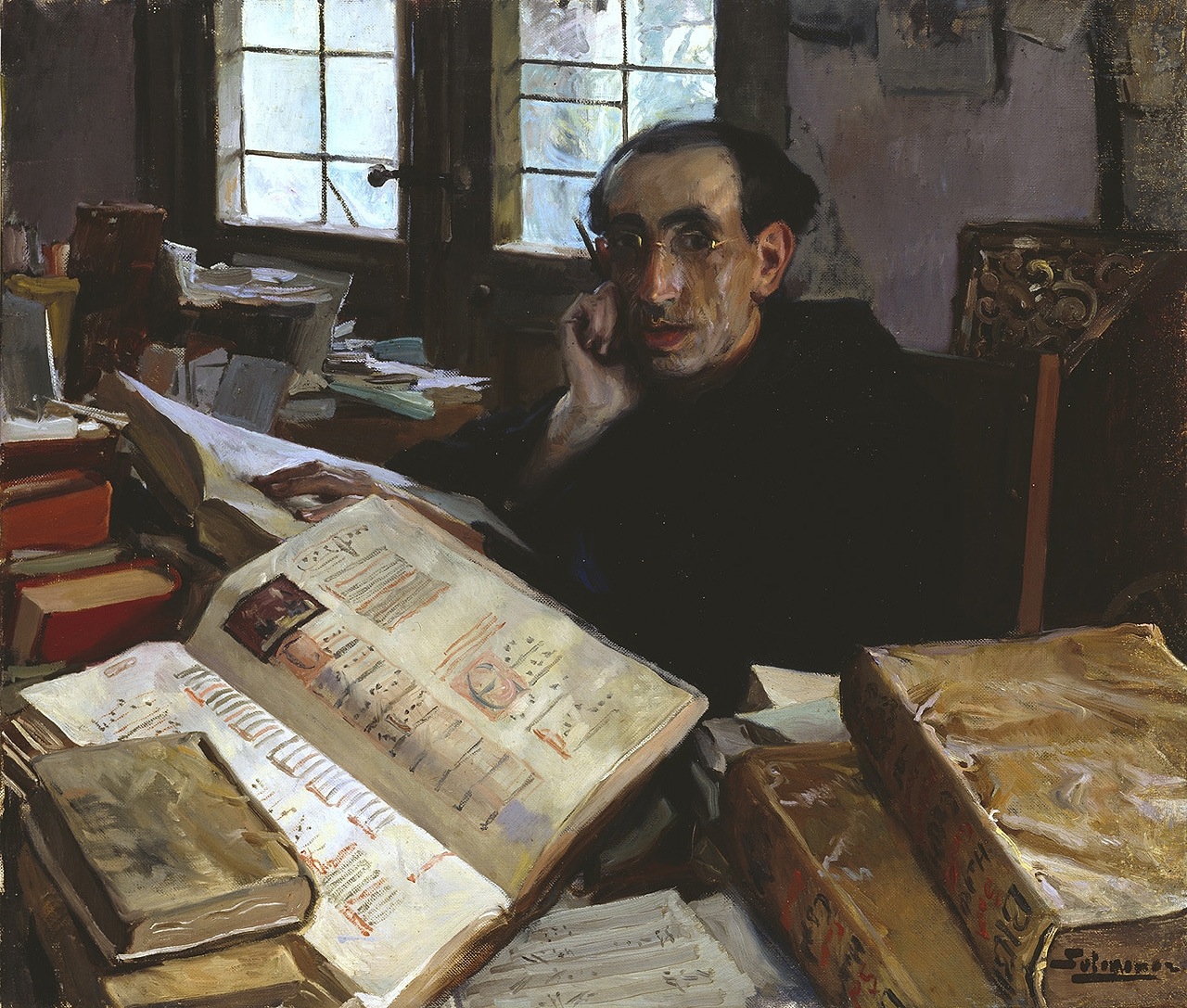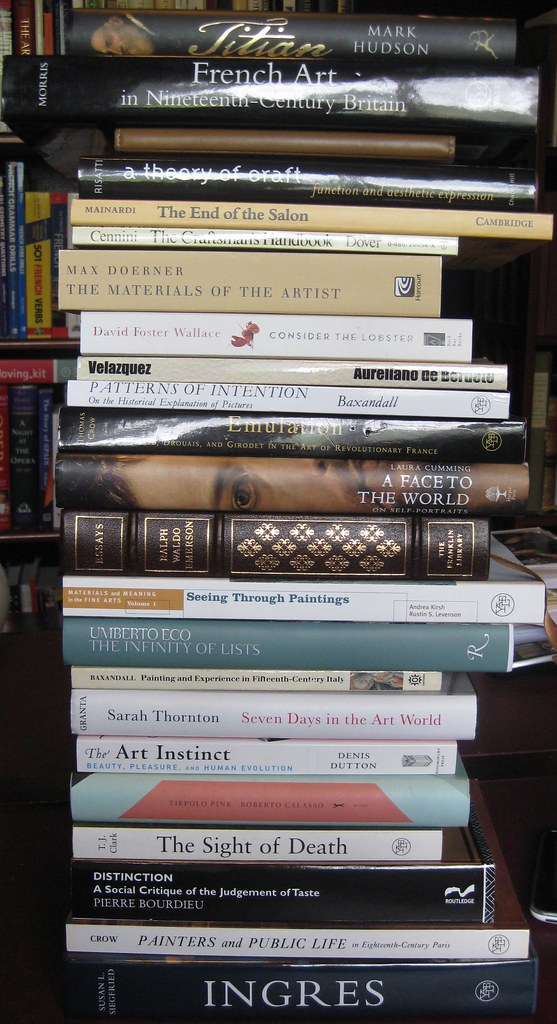Reader Question: What's on my nightstand?
___
Recently, I received an email from a BeardedRoman reader asking me for list of books on my nightstand. I thought I would post my answer here. And, I would love to know what is on your nightstand too.
I regularly get book recommendations from readers, and I love it. Through their suggestions and my own research projects, over the years I have built a large library. (At last count, I have nearly 1,500 books.) I have books piled by bed and all around my house. No, I have not read all of them–some were only bought for a single, useful chapter. Other I have read multiple times.
The books I have listed below are literally the ones that have been by my bed. I have my finger in every one of them and have been bouncing between them all for weeks. They don't necessarily relate to any current work I am doing–that's another pile. These are what I am reading for fun. As I made the list, I was surprised at how many were directly related to art history. (No wonder I am boring at parties.) But, as you can see from the list, my second love is poetry.
____
After naming the book and the author, I have written a very brief personal impression of each book.
- Titian: The Last Days by Mark Hudson. There are few straight biographies of Titian. Most that I have read are a scholarly studies of the artist's works combined with political and social commentary that would not be anything like reading the biography of, say, Benjamin Franklin. I've learned something about time an place from Hudson's book; but, overall I have struggled to get through it. Hudson seems to be as interested in talking about himself as he is about Titian.
- French Art in Nineteenth-Century Britain by Edward Morris. This is a great study of the relationship between the French and British at a time when the great international arms race was the arts. France was winning and the British couldn't help but admire the art it.
- Hopes and Fears for Art by William Morris. Morris was the philosophical and moral leader of the Arts & Crafts movement that was a reaction against industrialization. This is an impassioned lecture he gave in defense of his movement.
- Master of Shadows by Mark Lamster. This biography of Rubens is one of the best books I have read on any subject in a long time. Weaving together Rubens with the political and artistic dramas of his time, it is clear that the artist was as much a diplomat as a painter. I fell in love with Rubens again; both his art and his humanity.
- A Theory of Craft: Function and Aesthetic Expression by Kenneth R. Trapp. Lately, I've been obsessed with the role of craftsmanship versus concept in art. Does the way somethings is made matter; or, is it the final product that counts?
- The End of the Salon: Art and the State in the Early Third Republic by Patricia Mainardi. A very good discussion on how one of the most important institutions in the history of art fizzled out.
- The Craftsman's Handbook (Il Libro dell'Arte) by Cennino d'Andrea Cennini, trans. by Daniel V. Thompson, Jr. Perhaps one of the most widely-read handbooks for artists, this book is a lot of fun to read. Cennini wasn't always accurate; but, he does give an important insight into the practical considerations of making art in 15th-century Florence.
- The Materials of the Artist and their Use in Painting by Mac Doerner. So much of art history is about social and political history. I am anxious to learn more about the objects and how they were and art made.
- Consider the Lobster and Other Essays by David Foster Wallace. A recommendation from a friend, I cried while reading his essay on Dostoevsky.
- Velázquez by Aureliano de Beruete (Foreword by Léon Bonnat). Bonnat wrote the foreword just after being made Director of the Ecole des Beaux-Arts in Paris. His first sentence: "I was brought up in the worship of Velázquez."
- Patterns of Intention: On the Historical Explanation of Pictures by Michael Baxandall. Baxandall shatters me with almost every sentence. He has changed the way I've thought about paintings. Example: " . . . to say we 'explain a picture as covered by a description' can conveniently be seen as another way of saying that we explain, first, thoughts we have had about the picture, and only secondarily the picture."
- Emulation: David, Drouais, and Girodet in the Art of Revolutionary France by Thomas Crow. An amazing recreation of the events and journals of three of the most influential painters of the nineteenth-century. Very thoughtful.
- A Face to the World: on Self-Portraits by Laura Cumming. I wish I had written this book! Cumming writes about why artists make self-portraits and why we love looking at them.
- Essays by Ralph Waldo Emerson. I have been reading his essay "The Poet" over and over again. It's like scripture: each reading gets more meaningful.
- Seeing through Paintings by Andrea Kirsh and Rustin S. Levenson. A chemical analysis by two scientists on how art is made.
- The Infinity of Lists by Umberto Eco. Ever want to know how many demons have ever been named in Western literature? The basic premise of the book is that there is a history of list making in Western literature. From the Bible and Homer to Joyce, the lists say something about our culture. It's a surprising and entertaining read.
- Painting and Experience in Fifteenth-Century Italy by Michael Baxandall. My favorite quote: "Art was too important for artists."
- Seven Days in the Art World by Sarah Thornton. This is an mind-blowing, anthropological travelogue of the people who make, buy, and sell modern and contemporary art. Thornton is able to sit down with people and get candid reactions that made we alternatively laugh and want to reach through the page and strangle her interviewees.
- The Art Instinct: Beauty, Pleasure and Human Evolution by Denis Dutton. A discussion on why humans like art.
- Tiepolo Pink by Robert Calasso. Late in his career, Tiepolo did a series of 36 bizarre etchings that are rarely seen or discussed. This is a book about them.
- The Sight of Death: An Experiment in Art Writing by T. J. Clark. For several months, Clark works at the Getty Museum and sees the same paintings by Poussin day after day. This is his journal on impressions he had looking at them. It is amazing! The things he sees, the ideas he has, and the way he looks at these paintings have changed me. I want to be more like Clark. He is as much a poet as art historian.
- Distinction: A Social Critique of the Judgement of Taste by Pierre Bourdieu. While it is a few decades old, Distinction's basic premise is: your education and birth are the predominant indicators of why you like the music, food, and art you do.
- Painters and Public Life in Eighteenth-Century Paris by Thomas E. Crow. Great study on how artists joined the age of mass media.
- Ingres: Painting Reimagined by Susan L. Siegfried. I just got this, and haven't read much. But, it promises to be a new and controversial look at Ingres. Siegfried's goals are to examine in depth Ingres' history and genre paintings, which are largely ignored or dismissively categorized.
- Ballistics: Poems by Billy Collins. I have all of Collins' books of poetry.
- Los Versos del Capitan (Captain's Verses) by Pablo Neruda. I lived in Chile. Reading Neruda lets me slip back there, if only for a little while.
- Death in the Afternoon by Earnest Hemingway. This is a non-fiction book about bullfighting. As a result of studying Spanish painting, I have to know more about it. Bullfights (corridas) and bullfighters (toreros) are just part of the culture. I went to a bull fight last year at Las Ventas in Madrid. Since then, I've been trying to understand what happened and how I feel about it.
- Blizzard of One by Mark Strand. I have not even cracked it open yet.

